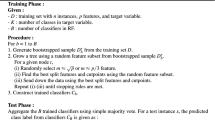Abstract
Classification of patterns is a key ability shared by intelligent systems. One of the crucial components of a pattern classification pipeline is the classifier. There have been many classifiers that have been proposed in literature, and it has been shown recently that ensembles of decisions trees tend to perform and generalize well to unseen test data. In this paper, we propose a novel ensemble classifier that consists of a diverse group of hierarchical clusterings on data. The proposed algorithm is fast to train, fully automatic and outperforms existing decision tree ensemble techniques and other state-of-the-art classifiers. We empirically show the effectiveness of the algorithm by evaluating on four publicly available datasets.







Similar content being viewed by others
Explore related subjects
Discover the latest articles, news and stories from top researchers in related subjects.References
Boser BE, Guyon IM, Vapnik VN (1991) A training algorithm for optimal margin classifiers. In: Proceedings of the fifth annual workshop on Computational learning theory, pp 144–152. ACM
Breiman L (1996) Out-of-bag estimation. Technical Report, Citeseer
Breiman L (2001) Random forests. Mach Learn 45(1):5–32
Bylander T (2002) Estimating generalization error on two-class datasets using out-of-bag estimates. Mach Learn 48(1–3):287–297
Cortes C, Vapnik V (1995) Support-vector networks. Mach Learn 20(3):273–297
Dredze M, Gevaryahu R, Elias-Bachrach A (2007) Learning fast classifiers for image spam. In: CEAS
El Ayadi M, Kamel MS, Karray F (2011) Survey on speech emotion recognition: features, classification schemes, and databases. Pattern Recognit 44(3):572–587
Erdélyi M, Garzó A, Benczúr AA (2011) Web spam classification: a few features worth more. In: Proceedings of the 2011 Joint WICOW/AIRWeb Workshop on Web Quality, pp 27–34, ACM
Felzenszwalb P, McAllester D, Ramanan D (2008) A discriminatively trained, multiscale, deformable part model. In: IEEE Conference on, computer vision and pattern recognition, CVPR 2008. pp 1–8
Fisher RA (1936) The use of multiple measurements in taxonomic problems. Ann Eugen 7(2):179–188
Freund Y, Schapire RE (1995) A desicion-theoretic generalization of on-line learning and an application to boosting. In: Computational learning theory, pp 23–37, Springer, Berlin
Friedman JH (2001) Greedy function approximation: a gradient boosting machine. Ann Statist 29(5):1189–1232
Gualdi G, Prati A, Cucchiara R (2011) A multi-stage pedestrian detection using monolithic classifiers. In: IEEE international conference on advanced video and signal-based surveillance (AVSS), pp 267–272
Guyon I, Gunn S, Ben-Hur A, Dror G (2004) Result analysis of the NIPS 2003 feature selection challenge. In: Advances in neural information processing systems, pp 545–552
Ho TK, Kleinberg EM (1996) Building projectable classifiers of arbitrary complexity. In: Proceedings of the 13th international conference on pattern recognition, 1996, vol 2, pp 880–885
Htike KK, Hogg D (2014) Efficient non-iterative domain adaptation of pedestrian detectors to video scenes. In: 22nd International conference on, pattern recognition (ICPR), 2014, pp 654–659
Htike KK, Hogg D (2016) Adapting pedestrian detectors to new domains: a comprehensive review. Eng Appl Artif Intell 50:142–158
Juang BH, Hou W, Lee CH (1997) Minimum classification error rate methods for speech recognition. IEEE Trans Speech Audio Process 5(3):257–265
Kwon OW, Chan K, Hao J, Lee TW (2003) Emotion recognition by speech signals. In: INTERSPEECH. Citeseer
Liaw A, Wiener M (2002) Classification and regression by randomforest. R News 2(3):18–22
Lichman M (2013) UCI machine learning repository. http://archive.ics.uci.edu/ml
Littlestone N (1988) Learning quickly when irrelevant attributes abound: a new linear-threshold algorithm. Mach Learn 2(4):285–318
MacQueen J, et al (1967) Some methods for classification and analysis of multivariate observations. In: Proceedings of the 5th Berkeley symposium on mathematical statistics and probability, vol 1, pp. 281–297. Oakland, CA, USA
Rosenblatt F (1958) The perceptron: a probabilistic model for information storage and organization in the brain. Psychol Rev 65(6):386
Rumelhart DE, Hinton GE, Williams RJ (1988) Learning representations by back-propagating errors. MIT Press, Cambridge, MA, USA
Russell S, Norvig P, Intelligence A (1995) A modern approach. Artificial Intelligence. Prentice-Hall, Egnlewood Cliffs 25, 27
Sánchez J, Perronnin F, Mensink T, Verbeek J (2013) Image classification with the fisher vector: theory and practice. Int J Comput Vis 105(3):222–245
Schapire RE, Singer Y (1999) Improved boosting algorithms using confidence-rated predictions. Machine learning 37(3):297–336
Szummer M, Picard RW (1998) Indoor-outdoor image classification. In: IEEE International workshop on, content-based access of image and video database, 1998. pp 42–51
Tzanetakis G, Cook P (2002) Musical genre classification of audio signals. IEEE Trans Speech Audio Process 10(5):293–302
Wagner A, Wright J, Ganesh A, Zhou Z, Mobahi H, Ma Y (2012) Toward a practical face recognition system: Robust alignment and illumination by sparse representation. IEEE Trans Pattern Anal Mach Intell 34(2):372–386
Walker SH, Duncan DB (1967) Estimation of the probability of an event as a function of several independent variables. Biometrika 54(1–2):167–179
Wang J, Yang J, Yu K, Lv F, Huang T, Gong Y (2010) Locality-constrained linear coding for image classification. In: IEEE conference on, computer vision and pattern recognition (CVPR), 2010, pp 3360–3367
Yang J, Chu D, Zhang L, Xu Y, Yang J (2013) Sparse representation classifier steered discriminative projection with applications to face recognition. IEEE Trans Neural Networks and Learn Syst 24(7):1023–1035
Yang M, Zhang L, Shiu SC, Zhang D (2013) Gabor feature based robust representation and classification for face recognition with gabor occlusion dictionary. Pattern Recogn 46(7):1865–1878
Yu B, Xu Zb (2008) A comparative study for content-based dynamic spam classification using four machine learning algorithms. Knowl-Based Syst 21(4):355–362
Author information
Authors and Affiliations
Corresponding author
Ethics declarations
Conflict of interest
The author declares that he has no conflict of interest.
Additional information
Communicated by V. Loia.
Rights and permissions
About this article
Cite this article
Htike, K.K. Forests of unstable hierarchical clusters for pattern classification. Soft Comput 22, 1711–1718 (2018). https://doi.org/10.1007/s00500-016-2434-1
Published:
Issue Date:
DOI: https://doi.org/10.1007/s00500-016-2434-1




